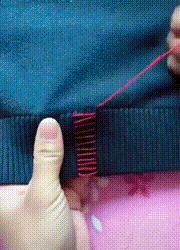22 They / Them / Their pronouns Sideblog for study stuff
Don't wanna be here? Send us removal request.
Text
LOVE the adhd thing where brain demands a very specific and simultaneously very vague type of stimulation and u can't figure out what it is
42K notes
·
View notes
Note
@death2america it’s how it’s being reported; I saw a headline for it earlier, one that literally said he “donated $10b” to something. Googled. And was like ah... So it’s not true then.
What do you think about jeff bezos donating 10 billion to climate change
pics or it didn’t happen
2K notes
·
View notes
Text
tonight, my list looks like:
put clothes in the dryer
make the bed
feed the chinchillas
feed the rats+put new chews in their cage
clean the chinchilla cage
take a break
take the bedroom trash bag out of the can+replace it
pick up trash in the kitchen+dispose of one of the old litter boxes
pour litter into the container*
break. a really important break.
take out litter box 1
break
take out litter box 2
break
spot clean litter box 3
spot clean litter box 4
put up dishes
break
organize my clothes
dryer load 2
hot cocoa+cartoons, pokemon, or stardew valley
sleep.
#Aveline.txt#Personal#to do#i have this all typed up on my phone; i just wanted to share#*this is one of the most exhausting parts; im physically weak and i struggle to lift even 15 lbs. the litter is over 30.#i dont mean to vent but ive been asking my husband to put the litter in the container for over a week and he just...hasnt done it...?#he tells me he'll help when i ask but sometimes he doesnt#like with the laundry or taking the trash out
0 notes
Text
dealing with executive dysfunction+physical limitations when you’ve got a lot of shit to do
make a list. the list will go like this:
start small on the list, with a few easier, more “lightweight” and “easy” things. (for example, my list starts with making the bed, feeding the chinchillas, etc.).
i always start with making my bed, so that i have somewhere to take a rest when i need it.
let yourself take a break after a 3-4 of these things. list the breaks off--but try not to feel pressured to push yourself to stick to it if you become pained or exhausted.
take the breaks.
increase the difficulty of your tasks just a little; theyll now require more energy/might be harder for you to do without chronic pain getting in the way. these are your “medium” tasks.
take breaks every 2-3 tasks.
put your “hard” tasks after those medium tasks. try not to push yourself too hard, though.
take a break every 1-2 task. dont overexert yourself, if you can keep from it.
have another set of small tasks last--just one or two (more if you can and want to do more). very small, easy tasks.
lastly, have a list of self-care tasks written out (if you don’t intend to go straight to bed, which is also self-care).
i personally make my list 30min to an hour before i get started on what im doing, in case i feel like i need to reorder things for convenience, or in case i want to add something or remove something
39 notes
·
View notes
Text

So like,,, don’t do this, okay? If there’s a patch of grass or something curbside, keep most, if not all, of your trash can on that. Okay? Okay. Thanks. 😒
It makes it really difficult for wheelchair users to get past. Especially today, since it’s muddy and rainy.
[ID: large trash cans and recycling bins are entirely blocking the path on a sidewalk. There is no way around it, except in the grass, or on the road. /end ID]
9 notes
·
View notes
Text

This is what I had to deal with today 😳😒
(ID: An empty wheelchair with jackets piled onto it; the wheelchair is caught between a bathroom stall door and the wall. There is no space or way to move it.)
Long story short: no matter how much I navigated this college campus’s bathroom, I couldn’t get into the stall until I stood and collapsed my chair which y’know, not everyone can do, because there was no room for me to navigate past the opening door. I couldn’t back out of the bathroom while opening the stall, either—the bathroom door caught on the stall door, and one could not fully open/close without the other impeding it and continuing to block me.
I literally could not get in or out of this bathroom without leaving my mobility aid, which is, as you can guess... Very bad.
It had a spacious stall, and even buttons to automatically open the door.
But those things were useless when my wheelchair couldn’t even get in or out.
Good for people with walkers/canes (unless their walker was the size of my wheelchair), but wheelchairs? No, god no.
#disabilities#wheelchair#wheelchairs#disabled#actually disabled#personal#im trying to breathe life into this blog and i kinda want it to be a place where i can talk about stuff like this and also studying?
0 notes
Photo

So I’ve seen a few handy posts floating around here, all about snacking healthily while studying, which most of us do 🙈 I’m not a nutritionist or a dietitian or anything, but I thought I’d compile a list of snackaroos that are good for you [plus some handy recipes!] ~ may not be appropriate for every culture, sorry!
• carrot / celery / cucumber sticks [+ low fat dip like hummus/tzatziki if you want!]
• raw fruit ~ banana, apple, orange, berries, melon, pear, etc
• dried fruit ~ dates, prunes, apricots, apples, etc [check that there is no / limited sugar or salt]
• oats [you can buy individual servings in sachets as a portable snack if you want]
• nuts ~ cashews, peanuts, macadamias, almonds, pistachios, etc [unsalted]
• low fat yogurt
• smoothies / smoothie bowls here, here and here or anything you think of [trust me on this okay avocado smoothies are 10000% better than they sound]
• cereal [not overly sweetened] ~ with milk / dry / with yogurt / + add chia seeds / fibre mix / protein powder
• eggs ~ scrambled, fried, poached, boiled = the world is your oyster [yeah i don’t have any egg puns]
• salads [u do make friends with salad relax] interesting = one two three + invent your own
• toast ~ WHOLEGRAIN OR WHOLEMEAL IF U CAN ~ low fat pb [mayvers is a grouse brand] + banana slices hallelujah, reduced-sugar jam, vegemite [hells yeah aus], margarine & cucumber is a rly good mix too
• wraps ~ hit up that wholegrain/spinach wrap w/ some lean meat and veggies i can promise you that it will be a good day friend
• canned fish ~ tuna/salmon/sardines get that brain food into you fam
> feel free to add more! xoxo
1K notes
·
View notes
Text
Why Japanese is EASY
A lot of people want to study Japanese but think it’s too hard and that they will never succeed. That is really a myth, though. Here is why Japanese is actually easy.
1. All verbs are regular, there are only 2 exceptions
If you know French, this must sound like a dream to you. In other languages [like French] there seem to be more irregular verbs than regular ones. Not in Japanese, though. There are 3 groups of verbs, the first 2 being regular and very easy to conjugate. The third group consists of only 2 irregular verbs!
2. Easy pronunciation
Japanese doesn’t have any exceptionally hard to pronounce letters. Unlike Arabic, German or Finnish, Japanese should be quite easy to pronounce for English speakers. Also, Japanese isn’t a tonal language like Thai or Chinese.
3. No genders, plural or articles
Anyone who studies a romance language [and many other languages that have that] knows how frustrating it can be when you use the wrong article or verb ending. In Japanese, it doesn’t even exist, so nothing to worry!
4. Grammar is easy!
That’s true. It’s just completely different from English, but that doesn’t make it hard. After a while, it will feel completely normal. The best part about the grammar is that you can build a whole sentence with just one word. For example, if you wanted to ask somebody in English if they did their homework, you’d say ‘did you do your homework?’ Kind of long, isn’t it? In Japanese, you can ask by using only the verb ‘to do, can, be able to’ - like this: ‘done?’ Also, spoken, you can drop many words if you don’t really need them, especially particles! So if you’re not sure what particle to use, chances are you can just easily leave it altogether without the sentence losing its meaning. It’s easy to build sentences that seem to end in ‘…’, but that’s completely normal in Japanese and everyone will understand.
5. Tons of resources
Sadly, there are some languages people don’t really care about or not a lot of people want to study/ are interested in. Japanese is not one of those languages. There are hundreds of books about Kanji alone! And so many courses for every level. Also, it doesn’t matter what you’re interested in - anime, manga, books, movies, game show, video games, dramas, music - it’s all out there and super easy to find, so you definitely will find something you can listen to or read to practice your skills.
6. Kanji/the writing systems are hard?
No. They aren’t. It’s just a huge workload, it takes time and effort, but they are not hard.
At first, having to learn 3 writing systems will seem exhausting. But believe me, later, when you start reading, you will be so glad! You can detect if a text has a lot of foreign words at one glance if it has a lot of Katakana, for example, and you could say a lot more on twitter because of the syllabaries!
So actually, the 3 systems put together makes everything easier to read!
So please, just start studying and go at your own pace, and have fun studying every day ⭐︎
12K notes
·
View notes
Text
For People Who Struggle With Unstructured Free Time
Or, For People Who Need To Get Work Done But Don’t Have Anyone Telling Them When To Do It
This can apply to basically any work that you need/want to get done: classwork, essays, exam studying, writing, trying to finish a project, etc. This is based off of a conversation I had with my mentor about how I was going to deal with approximately three months over which I have a dissertation and nothing else set to do (with the one caveat that I haven’t reached that time yet, so I can’t tell you yet how it works for me). It’s particularly for people who have executive functioning or time regulation issues, though it really can apply to anyone.
Schedule it like a job. No, seriously. Decide ahead of time what days/times you’re going to do the work and then do it at that time. It’s best if you pick the same days/times every week so you can set a routine.
Don’t do it every day if you can avoid it. Whatever you’re working on, you want to avoid burnout, particularly if it’s a long-term project, so you should give yourself breaks and days off.
Figure out what else you have scheduled/need to do ahead of time. I have a weekly thing, so my schedule will work around it. If I’m going to meet with friends, go do something, etc., I’ll figure it out beforehand and adjust my schedule accordingly.
Schedule other things. Particularly if the problem is that you struggle with unstructured free time, as I do, give yourself other scheduled things to do. My plan is to do a cultural thing once a week (go to a museum, see a sight, etc.). This way I’ll be filling a bit more of my time but won’t be doing work.
Schedule your work for when you work best. I work best in the afternoon and late at night. I’d rather not schedule work for late at night, so my schedule has me working in the afternoons. This means that I’ll be working while I’m most productive, while also leaving time to do whatever else I need/want to do.
Schedule across days rather than packing into one. Two hours four days a week is more manageable than eight hours one day. Don’t try to force yourself to do everything in one or two days, because you’ll get burnt out. Instead, pace yourself and figure out enough time per day to get into the swing of things without forcing yourself to work past the point that you can effectively manage.
956 notes
·
View notes
Photo

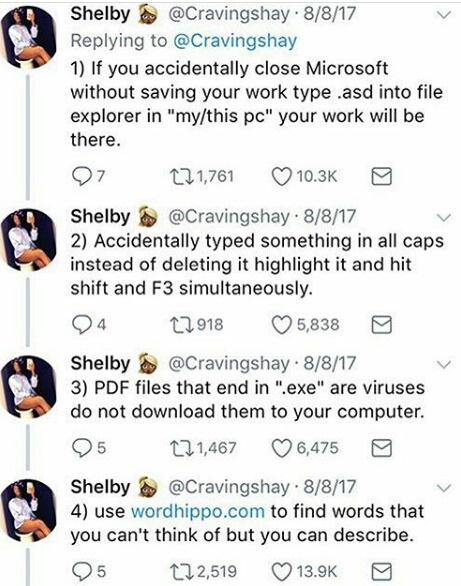
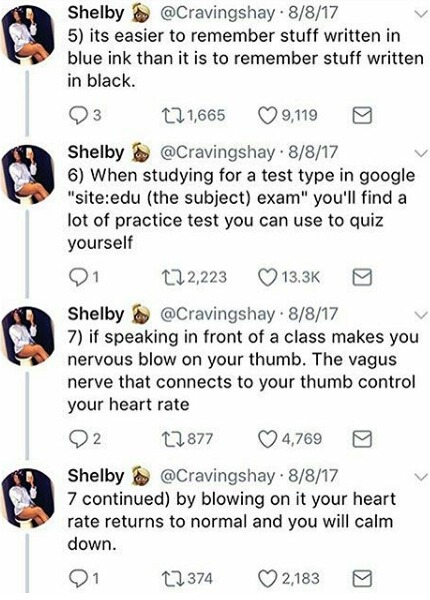
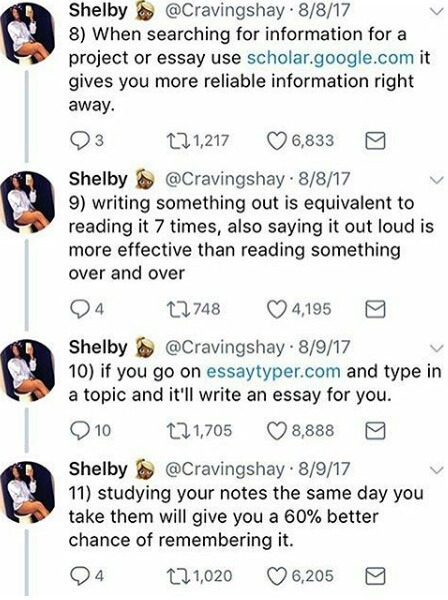
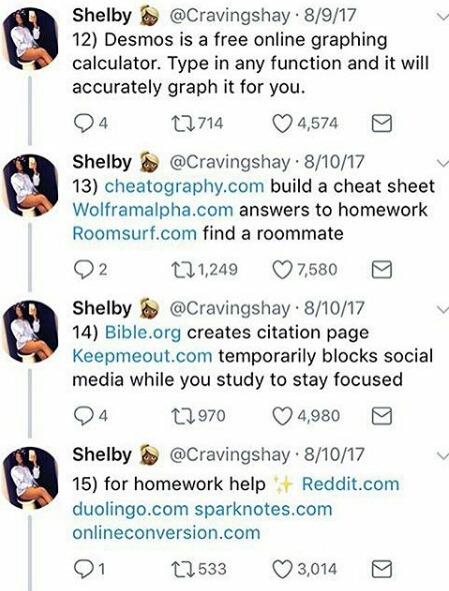
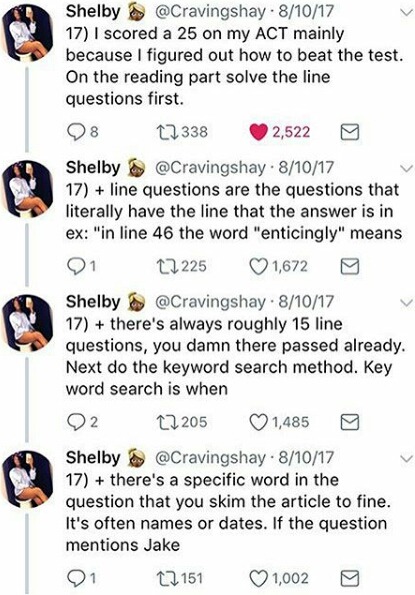
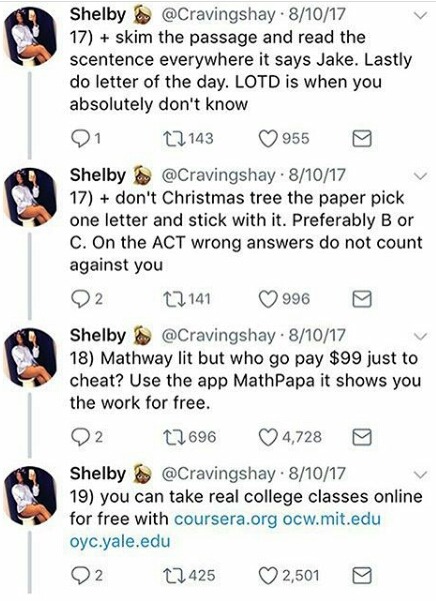

“A Thread of Tips” by Shelby
• #16 is missing but to find out more tips, follow her on twitter; be sure to thank her! 😁
disclaimer: check sites and tips before using at your own discretion.
201K notes
·
View notes
Link
Spread the Sign is an online multilingual sign language dictionary: you can type in a word, phrase, or fixed expression and get it translated into almost two dozen different national sign languages, including Swedish, British English (BSL), American English (ASL), German, French, Spanish, Portuguese, Russian, Estonian, Lithuanian, Icelandic, Latvian, Polish, Czech, Japanese, and Turkish.
Not all languages are available for every word, but all the ones I tried had at least a dozen or so languages available. Once you’ve searched for a word or phrase, you click on the flag for the national sign language that you want, and you can see a video clip of the sign as well as a translation into the same country’s spoken/written language.

It’s a project of the European Commission, so there tend to be more European languages — I notice a lack of Auslan (Australia), for example, so here’s a list of around 300 sign languages — but it’s definitely a great rebuttal to the idea that there’s only one sign language, as well as being incredibly interesting to click around!
Note though that it’s just a dictionary, and doesn’t account for grammatical differences between the languages in addition to the vocabulary, although you could probably recover some of the grammar from close attention to the phrases.
There is also a list of fifteen different sign alphabets, with images. Note that despite the fact that most of the fifteen languages are spoken in countries that use the Latin alphabet, their signs for, say, A, do not generally resemble each other. As a particularly obvious example, ASL has a one-handed alphabet while BSL has a two-handed alphabet. And Japanese Sign Language has signs for all the hiragana, which isn’t strictly speaking an alphabet. (Is the distinction between an alphabet and a syllabary still meaningful when you’re signing both of them? I…honestly have no idea. Apparently there is an Arabic Sign Language alphabet though, and none of the charts I found online include the short vowels, so I guess it would still qualify as an abjad? Wow, I don’t even know.)
2K notes
·
View notes
Text
Finding Some Fucking Motivation
If you’re a writer then you’ll know that motivation is a fickle motherfucking beast that will immediately abandon you if you even fucking think about taking it for granted.
With that in mind here are some great fucking ways to boost the fuck out of your motivation!
Make a kick-ass playlist; gather the shit out of the music that makes your heart pound and slam it into a fucking playlist and hammer that shit until you finish your draft.
Do some fucking exercise; right, arseholes. Get out there, in that world, and sweat your buns off and you’ll find that endorphins get off THEIR arses and do something useful and you suddenly want to more shit.
Do a shitty (writing) exercise; find a prompt you like and run with it to the fucking end. Either it’ll be shite or you’ll love it. Either way you wrote something and that’s a fucking win!
Take a fucking break; you deserve it, bitch! Rest makes us productive, don’t let the capitalist bullshit mentality of work till you die grind you down.
Find your fucking passion; if you don’t love your fucking story anymore, have a goddamn word with yourself and find out why. Life’s too fucking short to write shit you hate!
And check out these fucking resources, just in case they help;
Fucking finish your first draft
Writing good fucking sex
Sexy doesn’t always mean actual fucking
An extra nine fucking ways to motivate yourself
Learning to love your fucking craft
4K notes
·
View notes
Photo

(please, excuse my english. I have always talked about this topic in italian and I’m not super sure of some tecnical terms and words.)
Dyscalculia is difficulty in learning or comprehending arithmetic, such as difficulty in understanding numbers, learning how to manipulate numbers, and learning facts in mathematics. It is generally seen as a specific developmental disorder.
Basically, what a dyscalculic often can’t do is:
read numbers correctly.
do any basic arithmetic without a calculator.
understand the difference between multiplications and exponents.
solve problems that require a certain level of mathematical logic.
grasp and remember mathematical concepts, rules, formulae, and sequences
Some can also have difficulties with grammar rules and memorizing things such as declinations.
What a dyscalculic can and can’t do really changes from person to person, and what I have just written is just a very tiny part of the various symptoms.
Actually, there are a lot of usually simple tasks which are very difficult for dyscalculic people, such as:
Read analogic clocks.
Stating which is the larger of two different numbers.
Read musical notation.
Difficulty with conceptualizing time and judging the passing of time. You could be either always early (that would be me…) or always late.
Inability to concentrate on mentally intensive tasks.
Difficulty with choreographed dance steps.
Difficulty in orientating and reading maps.
Troubles estimating costs and keeping a budget.
Troubles estimating speed and distance.
What to do:
If you think you may have dyscalculia, I suggest you look and research a lot about it. If you still have that feeling, taking a test with a specialist i what you need to do. I’m not sure what the price is to take such a test in other countries, my therapist took me just 60 euros, but if you have free health care probably you can take them at an hospital for free.
Please don’t self-diagnose yourself. Having this kind of doubts and discussing about it with a therapist is OK! Nowadays is very very popular on Tumblr to self-diagnose yourself with anything, but if you have a learning disorder, you will need a document signed by a specialist to get help at school, so you need an official diagnose.
Now, you need to get actual help at school. Now, I really hope that your school is very open to that, and your teachers too. Sometimes they can very ableist and ignore completely the disorder. In this case, I recommend having your therapist talk to them.
You will probably get a paper after the evaluation (I believe that in the USA, CANADA AND UK its called IEP) which says what you can and can’t do, and decide how to proceed, which accomodations and modalities put in it ecc. You may have the possibility of keeping formulas and procedures to solve math, to always use a calculator, to just be tested orally instead of taking a regular test etc. The plan is customized, created to help you at this best.
Make sure that your needs are respected and that you get all the help you need to be at the same level as everyone in your class.
Find a way to make your math notes understandable and easy to read, with a good amount of examples, all the possible cases and with the theory well explained. If they let you keep this material with you during tests, like I do, this will be the most useful tool you’ll ever need to do math.
Different accomodations that you can get:
Mind maps and detailed procedures w/ examples in how to solve a particolar operation to keep during tests.
Keeping formulas with you during tests.
More time do to your tests.
Audio/videos explanations if you are an auditory learner.
Ability to keep a calculator with you during tests.
A tutor in or out the school.
Less questions in a test.
Help during tests.
Bigger font for your tests, files ecc… it may seem stupid, but is so nice to have a clearer view and bigger numbers!
More time to turn in your assignments and more time for your tests/exams.
Resources:
How to make math accessible.
More accomodations.
IEP.
PDP - if you are italian like me.
Some easy lessons.
Dyscalculia in one minute.
Skills affected by dyscalculia.
Video Lessons.
Dyscalculia.org
What is dyscalculia? (video)
For parents.
For teachers.
Dyscalculia math help collection.
The dyscalculia dolphin (our meme!)
Convert anything!
The Scale of everything. (can be overwhelming!)
Dyscalculator - a calculator for dyscalculics, depicts numbers four different ways: numerals, text, sound and a bar graph to compare two numbers. (android + iphone)
+ other links:
useful programs masterposts.
how to write an analytical/scientific essay.
cute ‘n unusual stationery.
how i take my math notes.
ADHD masterpost.
highlighting tips.
my pics.
Have a nice day xx
336 notes
·
View notes
Photo

Hello!
Since in my school we do group projects all the time and we have to use technology, I thought to make a post about all the programs we use to create mind maps, timelines and more!
Prezi: this is probably the best alternative to Power Point. It is for making cool presentations, but we use it for mind maps too. It offers many designs you can work with, or you can create your own. Browse some of these to see what you can create. Also, you can use any kind of stickers, pictures, shapes, videos, music and more. You can use it for free, but you have to keep your presentations public and cannot make them private; you will have to pay for a plan. But you can download your presentations as PDF!
Tiki-Toki: with this it is possible to create great timelines, really well made. You can create categories, add videos, photos, pretty much anything. Its great for school projects of keeping a timeline with the history of someone. It only has one big problem: you can create only one for free, you’ll need a premium membership to create more. Although we usually create multiple accounts to solve the problem.
Mindomo: great for mind mapping. I’m not really and epert on this one, since I don’t mind map at all, but I have seen this in action and it is really useful if you want to create a clear and nice mind map. Using it for free you can create 3 maps, then you’ll have to get a premium membership.
Realtime Board: you can use it for almost everything. Mind maps, timelines, projects. If you are a writer, you can make family trees too. You can make just three boards without a premium membership, but those boards are potentially infinite.
Edmodo: this is not exactly a program, but a chat (you can download it on your phone/tablet too) made so students and teachers can communicate and send their homework (even if for this I prefer Gmail and Drive, that allows the teacher to comment on the work with google documents). It may be very useful if used it the right way, unfortunately we don’t use it that often as the others.
So, thats it! Those are all the programs that we use, along with the majority of Google’s other services, in my school. Both teachers and students use it, but there is no need to attend a special class to create maps, presentations and more! I suggest to find more information yourself on the program you are interested in . this was just an introduction!
how to write an analytical/scientific essay.
cute n unusual stationery.
dyscalculia advice + resources.
how i take my math notes.
ADHD masterpost.
highlighting tips.
my @ig.
my pics.
618 notes
·
View notes
Photo
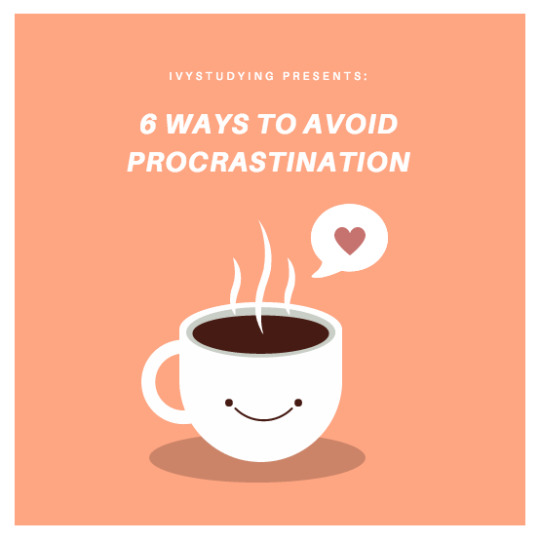

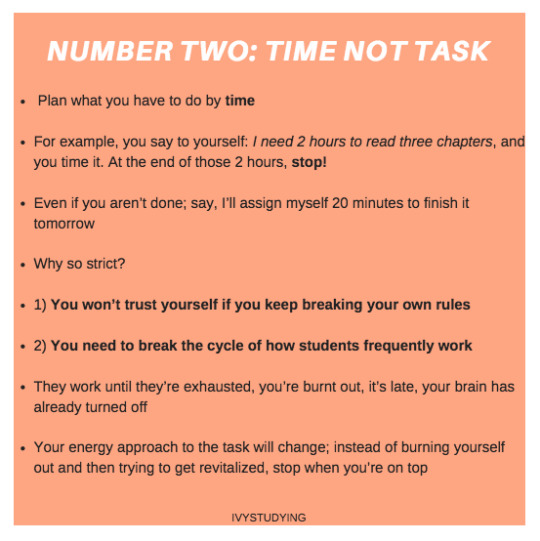




It’s been a while since I’ve made a post, and I figured that these tips might be extra helpful with exam season approaching. As someone who struggles a lot with procrastination, I do everything I can to fight the urge to put assignments off until the last minute (even though I’m not always successful).
As always, good luck! (ᵔᴥᵔ)
85K notes
·
View notes
